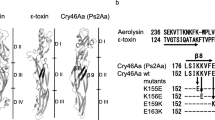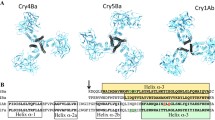Abstract
The widely accepted model for toxicity mechanisms of the Bacillus thuringiensis Cry δ-endotoxins suggests that helices α4 and α5 form a helix-loop-helix hairpin structure to initiate membrane insertion and pore formation. In this report, alanine substitutions of two polar amino acids (Asn-166 and Tyr-170) and one charged residue (Glu-171) within the α4–α5 loop of the 130-kDa Cry4B mosquito-larvicidal protein were initially made via polymerase chain reaction-based directed mutagenesis. As with the wild-type toxin, all of the mutant proteins were highly expressed in Escherichia coli as inclusion bodies upon isopropyl-β-d-thiogalactopyranoside induction. When E. coli cells expressing each mutant toxin were assayed against Aedes aegypti mosquito larvae, the activity was almost completely abolished for N166A and Y170A mutations, whereas E171A showed only a small reduction in toxicity. Further analysis of these two critical residues by induction of specific mutations revealed that polarity at position 166 and highly conserved aromaticity at position 170 within the α4–α5 loop play a crucial role in the larvicidal activity of the Cry4B toxin.
Similar content being viewed by others
References
Schnepf, E., Crickmore, N., Van Rie, J., Lereclus, D., Baum, J., Feitelson, J., et al. (1998). Bacillus thuringiensis and its pesticidal crystal proteins. Microbiol. Mol. Biol. Rev. 62, 775–806.
de Maagd, R. A., Bravo, A., and Crickmore, N. (2001). How Bacillus thuringiensis has evolved specific toxins to colonize the insect world. Trends Genet. 17, 193–199.
Hofte, H. and Whiteley, H. R. (1989). Insecticidal crystal proteins of Bacillus thuringiensis. Microbiol. Rev. 53, 242–255.
Crickmore, N., Zeigler, D. R., Feitelson, J., Schnepf, E., Van Rie, J., Lereclus, D., et al. (1998). Revision of the nomenclature for the Bacillus thuringiensis pesticidal crystal proteins. Microbiol. Mol. Biol. Rev. 62, 807–813.
Knowles, B. H. and Ellar, D. J. (1987). Colloid-osmotic lysis is a general feature of the mechanism of action of Bacillus thuringiensis delta endotoxin with difference insect specificity. Biochim. Biophys. Acta. 924, 509–518.
Grochulski, P., Masson, L., Borisova, S., Pusztai-Carey, M., Schwartz, J. L., Brousseau, R, et al. (1995). Bacillus thuringiensis CryIA(a) insecticidal toxin: crystal structure and channel formation. J. Mol. Biol. 254, 447–464.
Morse, R. J., Yamamoto, T., and Stroud, R. M. (2001). Structure of Cry2Aa suggests an unexpected receptor binding epitope. Structure (Camb.). 9, 409–417.
Li, J. D., Carroll, J., and Ellar, D. J. (1991). Crystal structure of insecticidal delta-endotoxin from Bacillus thuringiensis at 2.5 Å resolution. Nature. 353, 815–821.
Galitsky, N., Cody, V., Wojtczak, A., Ghosh, D., Luft, J. R., et al. (2001). Structure of the insecticidal bacterial delta-endotoxin Cry3Bb1 of Bacillus thuringiensis. Acta Crystallogr. [D. Biol. Crystallogr.] 57, 1101–1109.
Uawithya, P., Krittanai, C., Katzenmeier, G., Leetachewa, S., Panyim, S., and Angsuthanasombat, C. (1999). Abstract. 32nd Meeting of the Society for Invertebrate Pathology, p. 75.
Von Tersch, M. A., Slatin, S. L., Kulesza, C. A., and English, L. H. (1994). Membrane-permeabilizing activities of Bacillus thuringiensis coleopteran-active toxin CryIIIB2 and CryIIIB2 domain I peptide. Appl. Environ. Microbiol. 60, 3711–3717.
Walters, F. S., Slatin, S. L., Kulesza, C. A., and English, L. H. (1993). Ion channel activity of N-terminal fragments from CryIA(c) delta-endotoxin. Biochem. Biophys. Res. Commun. 196, 921–926.
Puntheeranurak, T., Leetachewa, S., Katzenmeier, G., Krittanai, C., Panyim, S., and Angsuthanasombat, C. (2001). Expression and biochemical characterization of the Bacillus thuringiensis Cry4B alpha1–alpha5 poreforming fragment. J. Biochem. Mol. Biol. 34, 293–298.
Gazit, E., La Rocca, P., Sansom, M. S., and Shai, Y. (1998). The structure and organization within the membrane of the helices composing the pore-forming domain of Bacillus thuringiensis delta-endotoxin are consistent with an “umbrella-like” structure of the pore. Proc. Natl. Acad. Sci. USA 95, 12289–12294.
Schwartz, J. L., Juteau, M., Grochulski, P., Cygler, M., Prefontaine, G., Brousseau, R., et al. (1997) Restriction of intramolecular movements within the Cryl1Aa toxin molecule of Bacillus thuringiensis through disulfide bond engineering. FEBS Lett. 410, 397–402.
Masson, L., Tabashnik, B. E., Liu, Y. B., Brousseau, R., and Schwartz, J. L. (1999). Helix 4 of the Bacillus thuringiensis Cry1Aa toxin lines the lumen of the ion channel. J. Biol. Chem. 274, 31996–32000.
Nunez-Valdez, M.-E., Sanchez, J., Lina, L., Guereca, L., and Bravo, A. (2001) Structural and functional studies of α-helix 5 region from Bacillus thruingiensis Cry1Ab δ-endotoxins. Biochim. Biophys. Acta. 1546, 122–133.
Gerber, D. and Shai, Y. (2000). Insertion and organization within membranes of the delta-endotoxin poreforming domain, helix 4-loop-helix 5, and inhibition of its activity by a mutant helix 4 peptide. J. Biol. Chem. 275, 23, 602-23607.
Uawithya, P., Tuntitippawan, T., Katzenmeier, G., Panyim, S., and Angsuthanasombat, C. (1998). Effects on larvicidal activity of single proline substitutions in alpha 3 or alpha 4 of the Bacillus thuringiensis Cry4B toxin. Biochem. Mol. Biol. Int. 44, 825–832.
Sramala, I., Leetachewa, S., Krittanai, C., Katzenmeier, G., Panyim, S., and Angsuthanasombat, C. (2001). Charged residues screening in helix 4 of the Bacillus thuringiensis Cry4B toxin reveals one critical residue for larvicidal activity. J. Biochem. Mol. Biol. Biophys. 5, 219–225.
Sramala, I., Uawithya, P., Chanama, U., Leetachewa, S., Krittanai, C., Katzenmeier, G., et al. (2000). Single proline substitutions of selected helices of the Bacillus thuringiensis Cry4B toxin affect inclusion solubility and larvicidal activity. J. Biochem. Mol. Biol. Biophys. 4, 187–193.
Angsuthanasombat, C., Chungjatupornchai, W., Kertbundit, S., Luxananil, P., Settasatian, C., Wilairat, P., et al. (1987). Cloning and expression of 130-kd mosquito-larvicidal delta-endotoxin gene of Bacillus thuringiensis var. israelensis in Escherichia coli. Mol. Gen. Genet. 208, 384–389.
Doyle, D. A., Morais, C. J., Pfuetzner, R. A., Kuo, A., Gulbis, J. M., Cohen, S. L., et al. (1998). The structure of the potassium channel: molecular basis of K+ conduction and selectivity. Science 280, 69–77.
Yuen, C. T., Davidson, A. R., and Deber, C. M. (2000). Role of aromatic residues at the lipid-water interface in micelle-bound bacteriophage M13 major coat protein. Biochemistry 39, 16155–16162.
Landolt-Marticorena, C., Williams, K. A., Deber, C. M. and Reithmeier, R. A. (1993). Non-random distribution of amino acids in the transmembrane segments of human type I single span membrane proteins. J. Mol. Biol. 229, 602–608.
Schiffer, M., Chang, C. H., and Stevens, F. J. (1992). The functions of tryptophan residues in membrane proteins. Protein Eng. 5, 213–214.
Tsang, S. and Saier, M. H., Jr. (1996). A simple flexible program for the computational analysis of amino acyl residue distribution in proteins: application to the distribution of aromatic versus aliphatic hydrophobic amino acids in transmembrane alpha-helical spanners of integral membrane transport proteins. J. Comput. Biol. 3, 185–190.
Pawagi, A. B. and Deber, C. M. (1990). Ligand-dependent quenching of tryptophan fluorescence in human erythrocyte hexose transport protein. Biochemistry 29, 950–955.
Author information
Authors and Affiliations
Corresponding author
Rights and permissions
About this article
Cite this article
Kanintronkul, Y., Sramala, I., Katzenmeier, G. et al. Specific mutations within the α4–α5 loop of the bacillus thuringiensis Cry4B toxin reveal a crucial role for Asn-166 and Tyr-170. Mol Biotechnol 24, 11–19 (2003). https://doi.org/10.1385/MB:24:1:11
Issue Date:
DOI: https://doi.org/10.1385/MB:24:1:11




